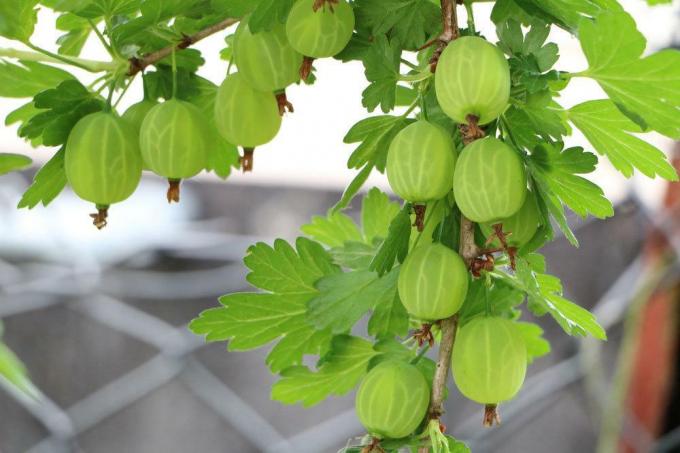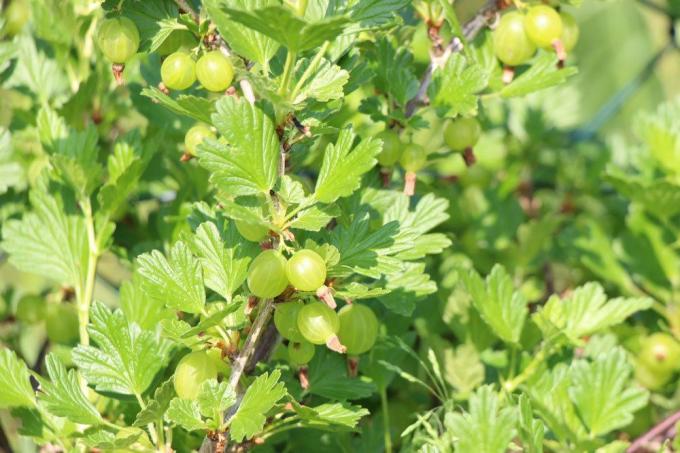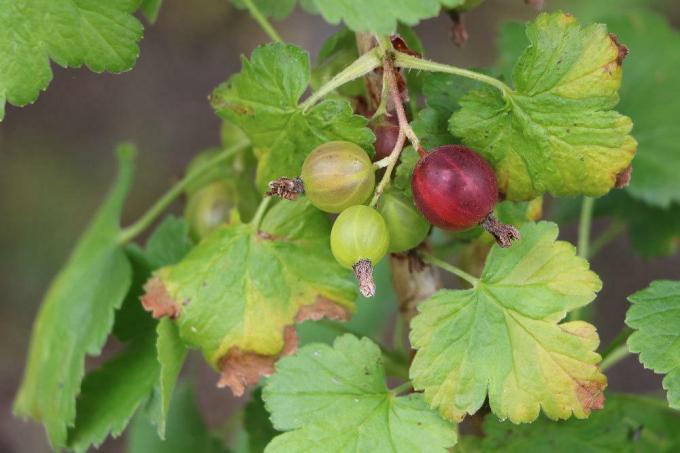
table of contents
- time
- Location
- preparation
- Planting gooseberries: instructions
- 20 gooseberry varieties
Sweet, sour and juicy. These three adjectives are a great way to describe home-grown gooseberries. If you want to enjoy the popular berries, you should plant one of the numerous varieties in the garden or in a container. In order to be able to plant Ribes uva-crispa, you don't even need a lot of knowledge, which is great for every beginner in gardening. With detailed step-by-step instructions, you will be able to implement this project in no time.
time
One of the most important things to consider when planting the ribes is timing. This determines the success of the project, as the shrubs need a certain amount of time to be able to establish themselves at a location. Since the plants are very robust, you don't have to wait too long for a direct appointment. Opt for either spring or autumn. Depending on the state of health of the specimen to be planted, you should bring it up to spring so that the gooseberry can recover. This is important, for example, after an illness that broke out after winter. You should plant young specimens in mid or late spring. Depending on the temperature in your region, not until after the ice saints in mid-May.
Location
In addition to the time, the location also plays an important role when planting. Only if this is enough for the requirements of the plant, they can become rich in autumn harvest and enjoy a vital gooseberry all year round. This should be as follows:
- Light requirement: sunny to light shade
- Orientation: southeast, south
- sheltered from the wind
- protected from late frosts
It is particularly advisable to choose a place under larger trees or bushes. This way, your gooseberry will not be exposed to direct radiation, which can quickly lead to sunburn. Plants that provide shade are Ribes uva-crispa's best friends and maintain the shrub's vitality. The soil of the site must also have certain characteristics:
- relaxed
- humus
- calcareous
- slightly damp
- moderate
If the desired location is too sandy or dry, mix some clay under the soil. That will do the gooseberry good. Just make sure that you don't add too much, otherwise waterlogging can occur. This in turn leads to an attack by fungi. Never let the soil dry out. The best way to do this is to use a drainage system made from gravel or potsherds. You should also pay attention to the location of how the gooseberry is kept. While many gooseberry varieties are ideal wild hedges with an extensive growth, there are just as many varieties that can be kept as columnar fruit. In this case, be sure to note how much space the plant really needs and choose the location accordingly.

tip: You can even raise gooseberries on a trellis. For this you should of course pay attention to the site conditions and the available space so that it does not get too tight or stuffy for the plant, as fresh air protects against fungal infections.
preparation
So that the gooseberries can establish themselves at the new location within a short time and with If sufficient nutrients are supplied over the first season, you should start with the soil preparation already about four weeks earlier kick off. This makes it easier for the plant to absorb nutrients, as these have been distributed excellently by then. Proceed as follows:
- Dig the planting pit
- Size corresponds to twice the root ball
- optional: 15 percent more for drainage
- 100 centimeters of space between two planting holes
- Spread drainage on the floor
- Mix excavated earth with ripe compost
- Fill again into the planting holes
In this way you can start immediately on the day of planting and make the further work easier.
Planting gooseberries: instructions
Once you've chosen a planting date and location, you're ready to start planting. Be sure to wear gardening gloves as a precaution if you choose a variety with thorns. Young specimens in most cases have significantly fewer or soft thorns, but these can also be painful. The following instructions explain step by step how to plant the gooseberries:
1. Carefully remove the Ribes uva-crispa from the bucket or the previous location. Do not damage any of the roots and check them for dried, broken or rotten spots. Carefully remove these with sharp scissors that have been disinfected beforehand. However, do not remove the soil with force, as the root ball of the plant grabs a lot of the substrate.
2. Prepare a bucket with fresh water and place the root ball in it until no more air bubbles rise to the top. If you have chosen the bare-rooted gooseberries, you can easily do without this step.
3. Carefully lift the gooseberries out of the bucket and place them immediately in the planting hole. Especially with young plants, make sure that they are upright, otherwise there may be problems with growth. A stick made of bamboo or wood is ideal for this. If you want to move a larger copy, you should get a second person to help. This will hold the shrub in place while you fill the planting hole.
4. The prepared soil is now filled up to the top and carefully pressed down with your hands. Don't pound the earth. You don't want to change the position of the gooseberries or compact the earth. The looser the better, because Ribes like to breathe.
5. After planting, water the site extensively. The soil should always be a little damp so that the Ribes uva-crispa can feel comfortable.
In the weeks after planting, you should make sure not to let the site dry out. This is especially important if you have decided to plant in late spring and the sun is getting stronger. Soil that is too dry can put a strain on the plants.

tip: If you want to increase the yield of your gooseberries, you should consider bee pastures and others bee-friendly plants such as willow, rosemary, sage, clover or apple trees in your garden establish. Despite the ability to self-pollinate, Ribes significantly increase the number of flowers and thus the yields.
20 gooseberry varieties
Now that you know how to plant Ribes uva-crispa, you should take a moment and look for a suitable variety. Like red or black currants, gooseberries are cultivated as numerous varieties that have different fruit sizes, resistances and care requirements. The biggest difference between the individual varieties is of course the color of the berries. These are either white, red, yellow or green and have a distinctly different taste, which is what makes the varieties so attractive. The following is a list of 20 attractive varieties for your garden:
1. Black Velvet
The 'Black Velvet' is an extremely aromatic variety with sweet, nuanced notes that stand out due to their dark red color, which almost turns black.
2. Green ball
This variety is a classic. Compared to the 'Black Velvet', the pulp shines through almost completely. Due to the stature height of a maximum of 100 centimeters, it is even suitable for small gardens.
3. Höning's earliest
This variety allows eating straight from the bush. Even raised as a high trunk, it bears a lot of fruits that show up early in the year.
4. Invicta
With the 'Invicta' you are offered a robust, undemanding and fungus-resistant variety that also enables a harvest with large yields. The berries are large, green and have an intense taste.
5. Ironmonger
Classic red variety from England known for its thin skin. The berries always hang in pairs and it is one of the varieties with the highest yields with a noble aromatic taste.
6. King of Trumps
A variety with a yellow skin and red marbling. Due to its juiciness, it is ideal for eating raw and freezing.
7. Larell
One of the thornless cultivars that is particularly suitable for keeping in pots on the balcony or terrace. She is also very healthy.
8. May Duke
The 'Maiherzog' is a breed from 1890 that is mainly used for preserving. The red berries can also be eaten raw.
9. Mucurines
This variety is one of the varieties that bear a lot of fruit. Seven to eight kilograms of green, egg-shaped berries hang on the subshrub at harvest time.
10. Pax
Another variety without thorns, which is also resistant to powdery mildew and other fungi. The fruits are nice and big and red.
11. Redeva
A purple variety with a lot of aroma that turns into sweetness. It is often used for the small garden, on the balcony or in the house, as it also has good resistance to powdery mildew.
12. Remarka
Powdery mildew does not affect this variety, which is mainly kept as column fruit. The dark red berries are fully juicy.
13. Resistenta
Yellow variety, which, according to its name, is resistant to powdery mildew and other fungal diseases. Well suited for humid regions.
14. Rex red
You can expect between six to seven kilograms of fruit from the variety, which is also mildew resistant.
15. Rocula
Round berries in dark red color adorn the shrub, which is resistant to fungi.
16. Rolonda
A variety with black-red fruits that can stay on the plant for a long period of time without suffering from powdery mildew or leaf fall disease.
17. Red triumph
A green variety that is considered a small rarity. Your berries are not very big, but suitable for green picking from the end of May.
18. Spinefree
Almost completely thornless. The red berries are very easy to pick, even for children.
19. White lion
A popular white variety for the bucket that is one of the oldest. The taste is extremely sweet.
20. Xenia
The unique thing about this Swiss breed is the orange aroma, which changes into a classic gooseberry taste. Definitely worth a try.
It is advisable to choose one of the fungus or powdery mildew resistant variants if you live in an area with persistent damp weather. Mushrooms spread much better in moisture and you do not have to do without cultivation if you have a resistant variety.

tip: If you have limited space in the garden, but want to plant red and yellow gooseberries, you should rely on the duo variety 'Hinnonmäki red and yellow'. This not only has a high resistance to powdery mildew, but also bears yellow and red berries on a bush, which makes it a popular variety.



